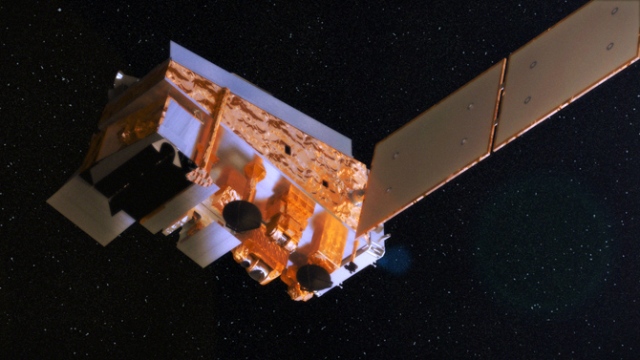Mar 5 2013
The Suomi National Polar-orbiting Partnership (NPP) satellite, a partnership between NASA and the National Oceanic and Atmospheric Administration (NOAA), was transitioned to NOAA operational organization control Feb. 22, 2013. The transition marks the next step of the mission that supports NASA's Earth science research and NOAA's weather forecasting missions.
 Artist's concept of the Suomi NPP satellite in space. Credit: NASA/Goddard Scientific Visualization Studio/Ryan Zuber
Artist's concept of the Suomi NPP satellite in space. Credit: NASA/Goddard Scientific Visualization Studio/Ryan Zuber
Suomi NPP continues the observations of Earth from space that were pioneered by NASA's Earth Observing System. The satellite's five instruments are providing scientists with data to extend more than 30 key long-term datasets. These records, which include observations of the ozone layer, land cover, atmospheric temperatures and ice cover, provide critical data for global change science.
"Suomi NPP is an important asset for NASA, NOAA, and the nation," said Michael Freilich, director of the Earth Science Division in NASA's Science Mission Directorate in Washington. "As a true collaboration in which all partners benefit, Suomi NPP measurements are supporting researchers and weather forecasters alike."
Suomi NPP also collects critical data for our understanding of long-term climate change while increasing our ability to improve weather forecasts in the short term. NOAA meteorologists are incorporating Suomi NPP information into their weather prediction models to produce forecasts and warnings that already are helping emergency responders anticipate, monitor, and react to many types of natural events.
"Satellites like Suomi NPP are critical to the National Weather Service's mission and improved decision support services," said Louis Uccellini, director of NOAA's National Weather Service. "These polar satellites provide an important dataset for the global Earth-observing system and will lead to improved forecasts out to three days in the future and beyond."
The Suomi NPP mission is a bridge between NASA's legacy Earth-observing missions and NOAA's next-generation Joint Polar Satellite System (JPSS). Suomi NPP carries groundbreaking new Earth-observing instruments that JPSS will use operationally. The first satellite in the JPSS series, JPSS-1, is targeted for launch in early 2017.
NASA launched Suomi NPP Oct. 28, 2011, from California. Since then, the JPSS program based at NASA's Goddard Space Flight Center in Greenbelt., Md., has been helping maintain the Suomi NPP instruments in addition to providing the ground system, with NOAA institutional organizations providing operational mission support. The NOAA operations group now assumes responsibility for Suomi NPP.
Suomi NPP instruments observe key attributes of the Earth, including measurements of cloud and vegetation cover, ice cover, ocean color, and sea and land surface temperatures. The suite includes the Visible/Infrared Imaging Radiometer Suite (VIIRS); the Cross-track Infrared Sounder (CrIS); the Clouds and Earth Radiant Energy System (CERES); the Advanced Technology Microwave Sounder (ATMS); and the Ozone Mapping and Profiler Suite (OMPS).
"Observations from Suomi NPP are helping to advance science and to increase the accuracy of short-term meteorological predictions," said James Gleason, Suomi NPP project scientist at NASA Goddard. "ATMS data are being used by the National Weather Service in their forecast models. And OMPS data continued over 30 years of ozone hole measurements helping the community put this year's smaller ozone hole in perspective."
Suomi NPP observes Earth's surface twice a day, once in daylight and once at night, flying 512 miles (824 kilometers) high in a polar orbit. The satellite sends its data once an orbit to a ground station in Svalbard, Norway. The information is transferred via fiber optic cable for processing at NOAA's Satellite Operations Facility in Suitland, Md. Data products are archived at the NOAA National Climatic Data Center in Ashville, N.C.
Suomi NPP is named in honor of the late Verner E. Suomi, a meteorologist at the University of Wisconsin who is recognized widely as the father of satellite meteorology.